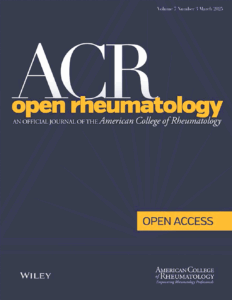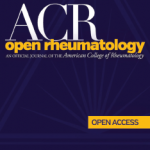 Editor-in-Chief Andras Perl, MD, PhD, anticipates broader scope & greater impact in the journal’s future
Editor-in-Chief Andras Perl, MD, PhD, anticipates broader scope & greater impact in the journal’s future
ACR Open Rheumatology (ACROR) is the newest of the ACR’s three peer-reviewed journals, publishing its first issue in March 2019. Since its introduction, the journal has provided high-quality articles, reporting on original investigations in all aspects of rheumatology-related research (e.g., basic science, clinical science, epidemiology, health outcomes and education), as well as reviews and commentaries in the field of rheumatology and related disciplines to clinicians, scientists, researchers and practitioners throughout the U.S. and around the world, doing so in an open-access format.
Open access is a key component, according to Andras Perl, MD, PhD, who became ACROR’s editor in chief in January 2024. He is the distinguished professor of medicine and chief of the Division of Rheumatology & Clinical Immunology at Upstate Medical University, Syracuse, New York, as well as a professor of biochemistry and molecular biology, and microbiology and immunology.
“The other ACR journals—the flagship journal Arthritis & Rheumatology, which has been around for many years, and Arthritis Care & Research—are available only to people who are subscribers [including ACR and ARP members] or who have access to subscribing libraries. But with ACROR, everyone has access to it without a subscription or library affiliation. That includes rheumatologists in private practice, general practitioners who care for rheumatology patients or the patients themselves across the globe,” said Dr. Perl.
With a year as editor in chief under his belt, Dr. Perl sat down with The Rheumatologist (TR) to discuss his approach to ACROR, including his push to broaden the range of articles and increase the journal’s impact.
TR: Let’s start with your background, which includes earning your MD and PhD from Semmelweis Medical University in Budapest, Hungary, doing your fellowship in rheumatology at the University of Rochester Medical Center, New York, and now holding positions at Upstate Medical University.

Dr. Perl
Why did you decide to travel to North America, and how does your background play into your role as ACROR’s editor in chief?
Dr. Perl: I originally came to the U.S. to pursue research. At that time, there were many more opportunities and resources in the U.S. to learn about advancements in this field, so I applied for and got a three-year fellowship at the University of Rochester.
After I completed [my fellowship] in 1992, I actually went back to Hungary, but the political system was undergoing substantial change. And after just five months, I decided the U.S. was a better option for continuing my research career at that time.
Basic research has been central to my career, which has focused on the contribution of genetic and environmental factors in shaping immune response, particularly autoimmunity as it relates to lupus. And I also do clinical trials. That combination has given me a broad perspective when it comes to ACROR.
TR: Your research has revealed several genetic-metabolic-environmental interactions, notably as they relate to systemic lupus erythematosus (SLE), and may open pathways to therapeutic interventions. Would you provide a little more detail on your research?
Dr. Perl: I have been interested in immunology, and lupus has fascinated me as a very complex disease that has a strong connection to autoimmunity. As time has passed, our understanding about the important contributions of genetics has grown. For instance, we now know that certain gene variants are linked to SLE and that variations in a combination of genes can increase the risk of developing SLE.
We have learned that environmental factors, including viruses, microbiota, nutrients and diet, have major impacts on the functioning of the immune system. We have also learned more about the cell types that make up the immune system, and [gained] much more granular knowledge of the many different cell subsets and how plastic and responsive they are to environmental factors. All of that combined has made the science behind autoimmunity very fascinating to me and remains my primary research focus.
This research has led to basic science grants from the U.S. National Institutes of Health (NIH) to develop models of autoimmune diseases, including lupus, of course. For instance, we continue to study lupus susceptibility genes in the laboratory and have identified a number of them that regulate metabolism, which is a process that integrates how the environment interacts with the genome. In other words, genes determine how metabolism works, and what we eat and what we breathe—the environment—also has an impact on metabolism. Going back 25–30 years, when we explored the role of metabolism in immune cell activation, it was considered a simple housekeeping process. And now, this newly emerged field of immunometabolism is a very hot topic.
And then, I also conduct clinical trials in lupus, including a current NIH-supported trial that has many centers participating across the country. [Author’s note: Funded with a $7.2 million grant, the five-year clinical trial is testing whether the antioxidant N-acetylcysteine (NAC) is a useful treatment for SLE. Nearly two dozen lupus centers around the country and about 250 patients are participating in the trial, which will continue into 2026.]
TR: How does your involvement in research and clinical trials influence your approach to ACROR?
Dr. Perl: In the past, ACROR has emphasized the outcomes of various diseases, including the effect of social situation, race, sex, ethnicity and income level, on outcomes. I would like to move the journal more toward a balance of articles that includes basic and translational research, as well as outcomes. This [approach] will give it a portfolio somewhat similar to that of Arthritis & Rheumatology, but with outcomes articles that are the hallmark of Arthritis Care & Research, and doing it all in ACROR’s open access format.
TR: How has this combination portfolio played out in ACROR so far?
Dr. Perl: Right now, I am especially interested in increasing the number of basic science articles. I just looked at the papers coming out in the [January 2025] issue, and basic science articles make up about 20–25% of the articles overall. But ideally, I would like to increase that to 50%. To do that, we need submissions.
TR: Are you taking steps to attract more basic science manuscripts?
Dr. Perl: I am not actively seeking basic science papers, but I am welcoming them. The editorial board has been reshuffled, so we now have more board members who are basic scientists. I am hoping that will inspire people who have such studies or such areas of expertise to submit to this journal. Until now, they have had to take their submissions to basic science journals, even if they had rheumatological topics, but I would like to publish their work in this journal going forward.
TR: What else do you have planned for ACROR?
Dr. Perl: I would like to speed up the submission-to-publication time. Although the publication review process has significantly accelerated in the past year, I would like to recruit more reviewers and focus more on papers that are ready to publish, which will speed it up even more.
On the manuscript reviews, we typically accept less than half of the submitted papers for review, and they go out to ACROR’s deputy editors, Dr. Tsokos handles basic science articles and Dr. Lane focuses on clinical/translational research articles. [Author’s note: George C. Tsokos, MD, is chief of rheumatology and clinical immunology, Beth Israel Deaconess Medical Center, Boston. and professor of medicine at Harvard Medical School, Boston. Nancy E. Lane, MD, is a distinguished professor of rheumatology at University of California, Davis Health, Sacramento.]
Besides that, I am working with teams from the ACR and Wiley to update the website and highlighting papers in a newsletter that comes out with each journal. Each highlight includes a blurb summarizing the paper, and the author reviews it before it goes live.
We also have a social media presence, so the highlights are also published there. In addition, we are asking authors to prepare a digital, or even video, abstract of their study that is social media friendly, so it can appear there as well. The ACR’s digital content director, Brian Robinson, has expanded our social media presence to the new and rapidly growing Bluesky platform.
We have a fantastic supporting team in [ACR employees] Maggie Parry and Chris Reynolds, and [Wiley employee] Adam Mlodzinski.
TR: Is anything else in the works for ACROR?
Dr. Perl: Of course, we are always seeking to improve the quality of the articles and continually enhance the impact factor of the journal. At present, our papers do not include the massive datasets that are expected in very high-impact journals. So I am working to attract papers that have larger datasets and are of higher caliber. I have been talking to researchers about that, and we are already getting some very good submissions. The future of the journal looks good.
TR: In terms of the papers submitted, are you seeing any trends, perhaps incorporating artificial intelligence (AI)?
Dr. Perl: One trend is AI-created datasets. I am also reviewing for other journals, and many are getting paper submissions that smell like they are created by AI. In other words, it is hard to determine if they have real and new information in them, or [if these papers] are basically just re-mined, existing data.
These AI-created datasets are often impenetrable. I am personally not in favor of publishing those articles and instead favor hypothesis-driven research that is validated in experiments.
So, in summary, yes, AI-created datasets can find something that is new and interesting, but I think that any hypothesis needs to be validated under sound experimental conditions, which may be a clinical trial or an animal or cell-line model. That is my personal view. It’s hard to appreciate the veracity of those papers that come out of these purely dataset analysis or so-called dry lab studies—and there are many of them out there now.
TR: A lot goes into being the editor in chief of a journal, between staying on top of trends in research, changes in clinical care and just reaching the journal’s audience today given the demands on their time and the growing clutter of the information age. Why did you decide to take on a five-year term as ACROR editor in chief?
Dr. Perl: I love science, I’m a curious person, and I am easily excited when reading something that is not published yet. The transition into this position has been straightforward, actually. Although I have officially been the editor in chief since Jan. 1, 2024, I began receiving new submissions to the journal the previous fall and was able to talk to Patty Katz and Ed Yelin, who co-founded the journal and were ending their terms as its co-editors in chief. [Author’s note: Patricia Katz, PhD, is professor emerita of medicine and health policy, and Edward H. Yelin, PhD, is the Edward A. Dickson Emeritus Professor of Medicine, both at the University of California, San Francisco.] Patty was especially helpful in guiding me through the mechanics of managing papers online. She graciously agreed to stay on as associate editor.
In addition, Adam Mlodzinski, the managing editor assigned by the publisher Wiley, was very good in assisting with the journal during the transition and remains a valued part of the editorial team. In fact, the ACR publications people at all levels are really good. They know what they are doing, are full of enthusiasm and are just a very good team to work with. I’m not just saying that; it’s honestly true. So really, the transition into the role of editor in chief has been an easy one.
I am looking forward to my next four years as editor in chief and watching ACROR continue to evolve, increase its impact and provide good quality, peer-reviewed and open access articles to our ACR members and readers across the world.
Leslie Mertz, PhD, is a freelance science journalist based in northern Michigan.
ACROR Online
Gain access to ACR Open Rheumatology’s full archive online at: https://acrjournals.onlinelibrary.wiley.com/journal/25785745.




